Queue Management System in Banking
Revolutionizing Customer Experience: How Queue Management Systems are Transforming Banking Services
In an era where customer expectations are at an all-time high, banks are stepping up their game to deliver exceptional service. Queue management systems are at the forefront of this transformation, redefining how customers experience banking. Gone are the days of long waits and frustration; these innovative solutions streamline the process, ensuring that clients receive timely assistance tailored to their needs. By harnessing advanced technology, banks can optimize their workflows, reduce congestion, and enhance overall satisfaction. As we delve deeper into how these systems are revolutionizing customer experience, we’ll explore the tangible benefits they bring to both financial institutions and their clients. It’s more than just efficiency; it’s about building lasting relationships and fostering trust in a competitive landscape. Ready to uncover the future of banking? Let’s explore how queue management systems are not just a trend, but a vital component of exceptional service delivery.
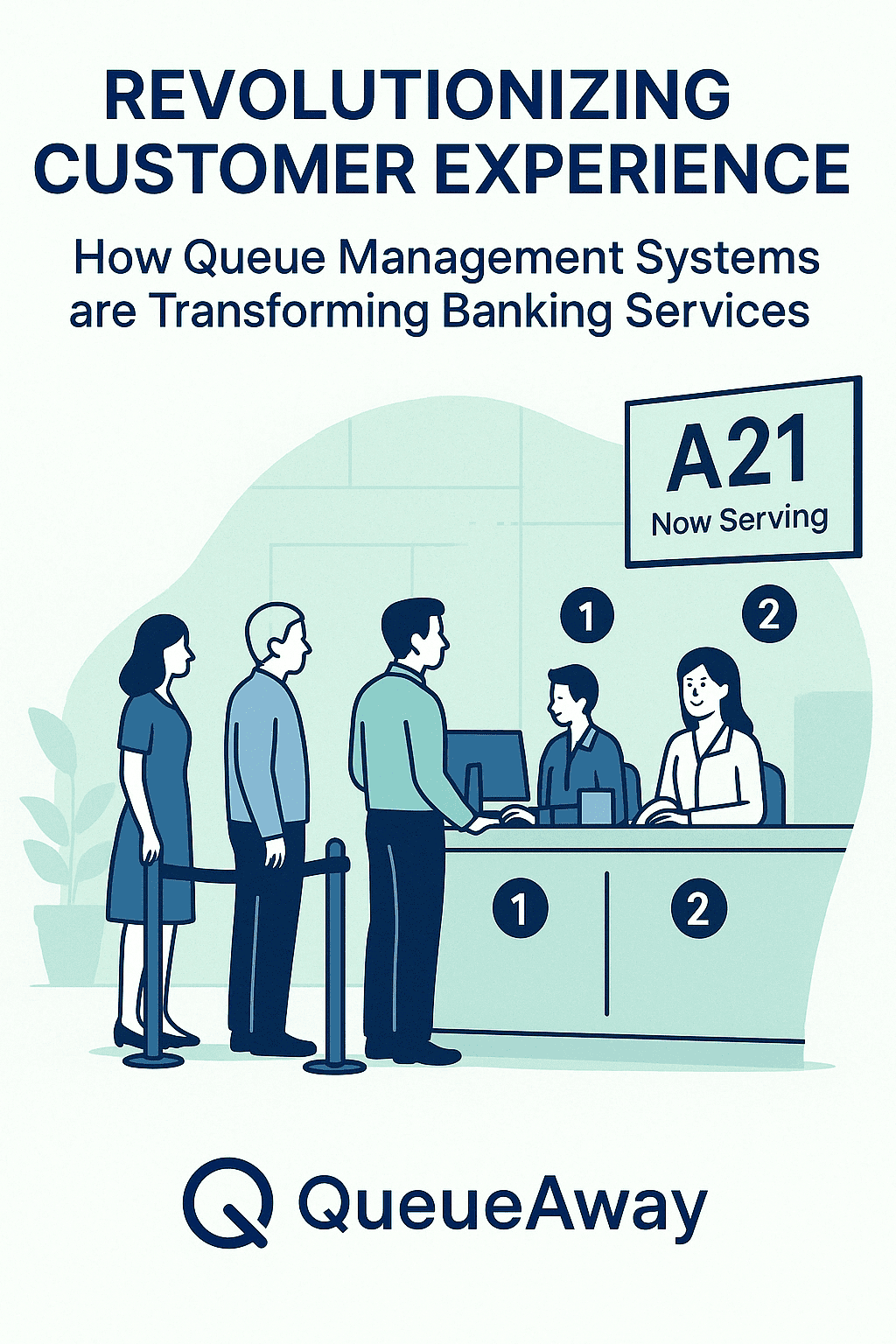
Revolutionizing Customer Experience in Banking – QueueAway in ActionQueueAway’s queue management system transforms banking services by reducing wait times, improving staff efficiency, and enhancing customer satisfaction through smart, streamlined service delivery.The Importance of Customer Experience in Banking
In today’s fast-paced world, customer experience has become a cornerstone of business success, particularly in the banking sector. The stakes are higher than ever, as clients expect not only financial stability but also seamless interactions and personalized services. Banks are no longer just places to store money; they are integral parts of daily life, influencing everything from personal finances to major investments. As such, the quality of customer experience can significantly impact a bank’s reputation and customer loyalty.
Customer experience in banking encompasses a wide range of factors, including the ease of accessing services, the efficiency of transactions, the responsiveness of customer support, and the overall atmosphere of the banking environment. Customers are seeking more than just basic transactions; they want to feel valued and understood. This has pushed banks to adopt new strategies and technologies to meet these evolving demands. One of the most critical aspects is the management of customer queues, which directly affects how clients perceive the institution.
The modern consumer is increasingly intolerant of long wait times and inefficient processes. The frustration of standing in line or waiting for service can lead to negative perceptions and ultimately drive clients away. Therefore, banks must prioritize optimizing their operations to ensure a smooth and swift customer experience. By leveraging advanced queue management systems, banks can transform these interactions, providing timely and tailored assistance that enhances overall satisfaction and fosters long-term relationships.
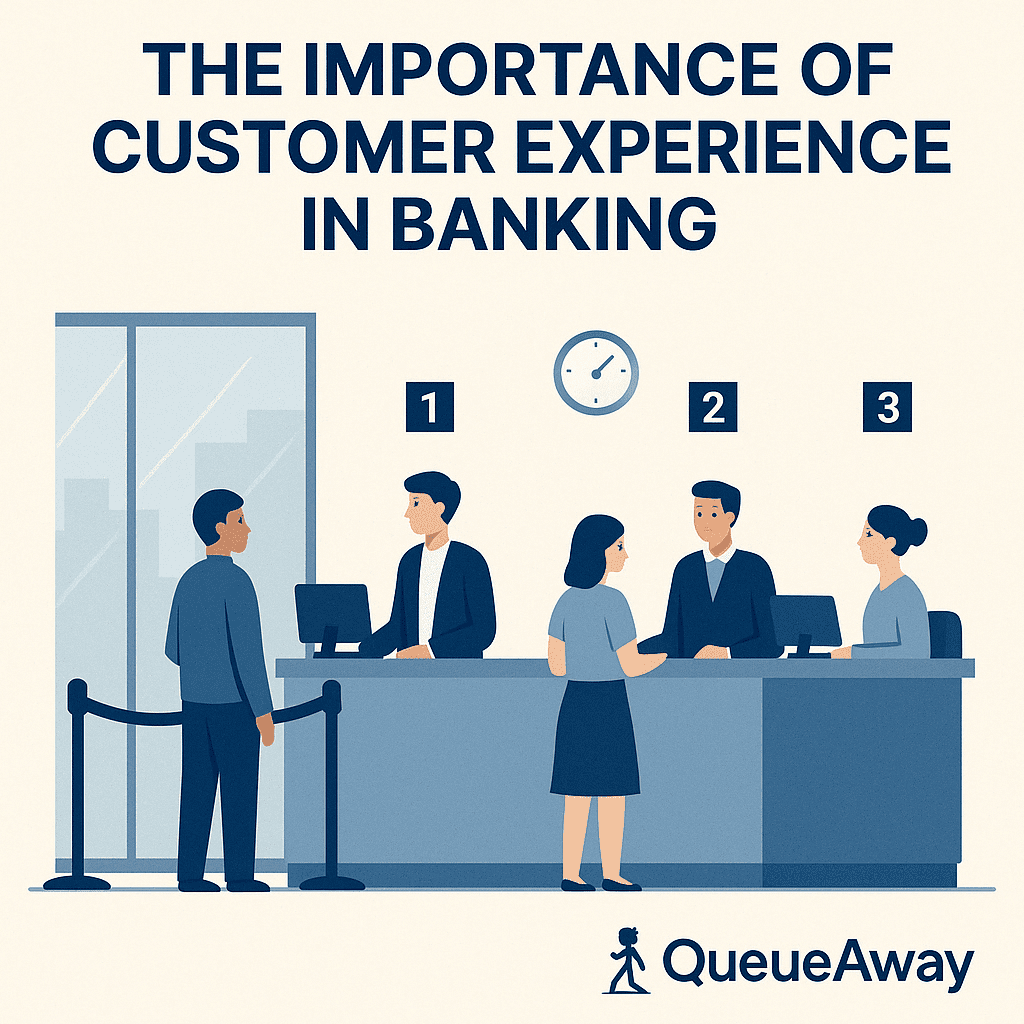
The Importance of Customer Experience in Modern Banking – Powered by QueueAwayCustomer experience shapes banking success, emphasizing efficient service delivery at teller counters using QueueAway’s queue management systemHow Queue Management Systems Work
Queue management systems are sophisticated technological solutions designed to streamline customer flow and service delivery in banking environments. These systems employ a combination of hardware and software to monitor, control, and optimize queues, ensuring that clients receive prompt and efficient service. At their core, these systems track customer arrivals, manage waiting times, and allocate resources effectively to minimize delays and enhance service quality.
The operation of queue management systems begins with the identification of customer needs upon their arrival. This can be achieved through various methods, such as self-service kiosks, mobile applications, or reception desk interactions. Once a customer’s requirements are identified, the system assigns them a position in the queue and provides real-time updates on their waiting time. This transparency helps alleviate frustration and keeps clients informed about their service status.
Advanced queue management systems integrate with other banking technologies, such as customer relationship management (CRM) systems, to provide a holistic view of client interactions. This integration allows banks to tailor their services based on individual preferences and history, further enhancing the customer experience. By dynamically adjusting queue priorities and resource allocation, these systems ensure that urgent needs are addressed promptly while maintaining overall efficiency.
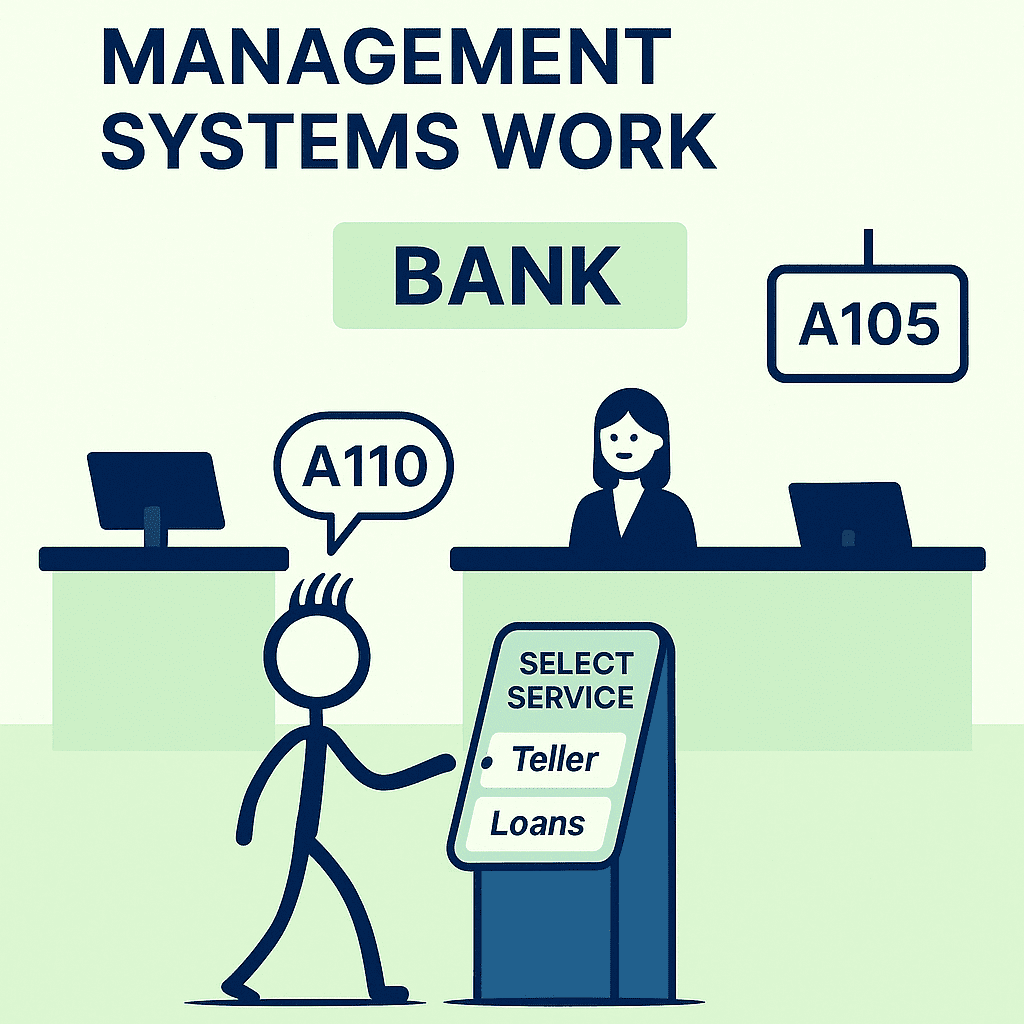
How Queue Management Systems Work in Modern Banking – QueueAwayOperation of a bank queue management system, showing customer check-in via kiosk, ticket number assignment, and real-time updates to streamline service using QueueAway.Key Features of Modern Queue Management Systems
Modern queue management systems come equipped with a myriad of features designed to enhance customer experience and streamline banking services. One of the most notable features is the ability to offer multi-channel queueing options. Customers can join a queue through various platforms, such as mobile apps, online portals, or physical kiosks, providing flexibility and convenience. This multi-channel approach ensures that clients can access services in a manner that best suits their preferences and circumstances.
Another key feature is the provision of real-time updates and notifications. Customers receive timely information about their position in the queue, estimated waiting times, and any changes in their service status. These updates can be delivered via SMS, email, or mobile app notifications, keeping clients informed and engaged throughout the process. This level of transparency helps reduce anxiety and frustration, contributing to a more positive experience.
Analytics and reporting capabilities are also integral to modern queue management systems. These tools enable banks to monitor and analyze queue performance, customer behavior, and service efficiency. By leveraging data insights, banks can identify areas for improvement, optimize resource allocation, and implement targeted strategies to enhance service delivery. Additionally, these systems often include feedback mechanisms, allowing customers to provide input on their experience, which can be used to further refine and improve services.
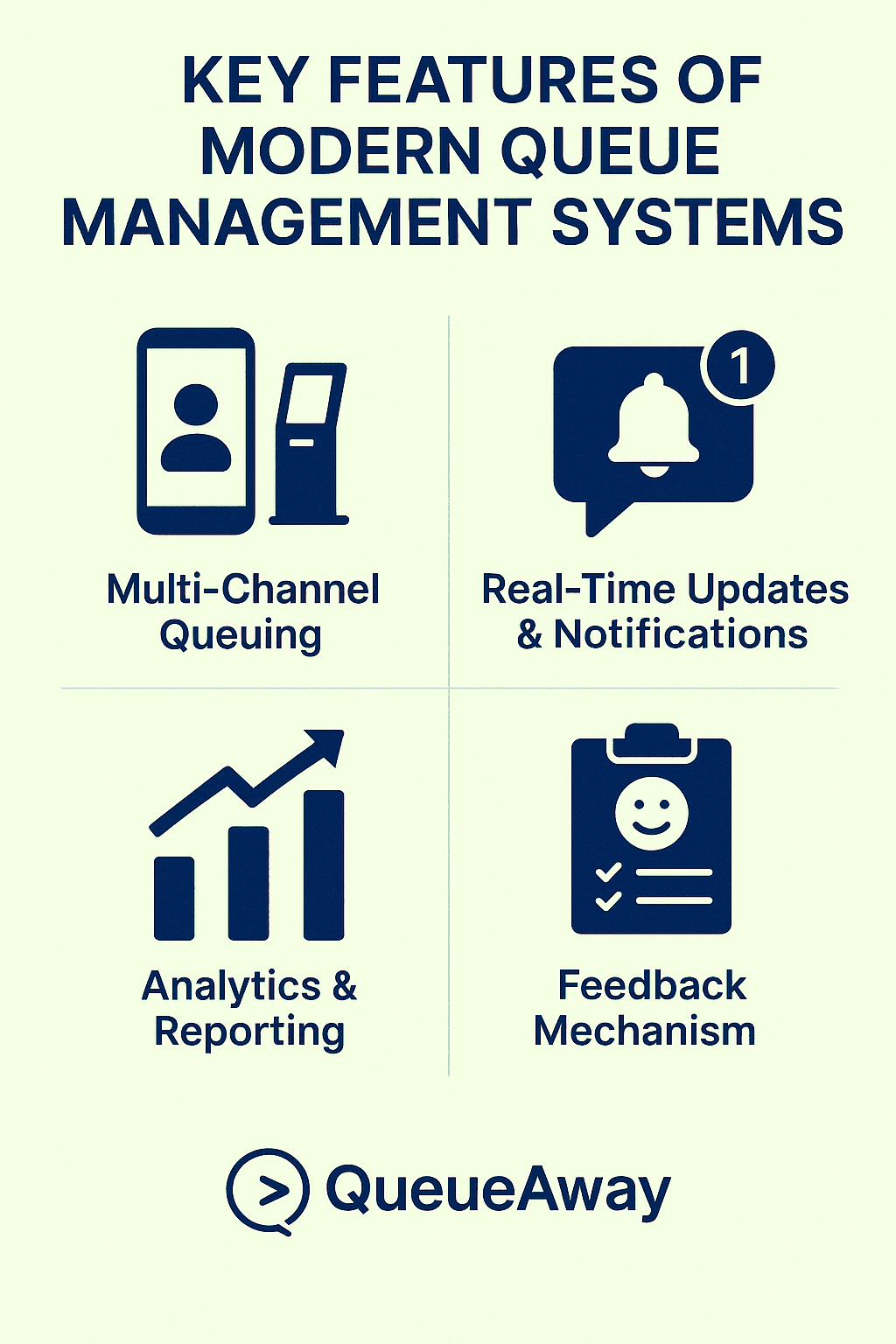
Key Features of Modern Queue Management Systems – Powered by QueueAwayEssential features of modern queue management systems—multi-channel queuing, real-time notifications, analytics, and feedback tools—all designed to improve service delivery and customer experience with QueueAway.Benefits of Implementing Queue Management Systems in Banks
The implementation of queue management systems in banks brings a host of benefits that extend beyond mere efficiency. One of the most significant advantages is the reduction of wait times, which directly impacts customer satisfaction. By streamlining the queueing process, banks can ensure that clients receive timely assistance, reducing frustration and enhancing their overall experience. This improvement in service delivery can lead to increased customer loyalty and positive word-of-mouth referrals.
Queue management systems also contribute to better resource utilization. By accurately tracking customer flow and service demands, these systems enable banks to allocate staff and resources more effectively. This optimization helps prevent bottlenecks, ensures that peak times are managed smoothly, and reduces the strain on employees. As a result, staff can focus on providing high-quality service rather than managing chaotic queues, leading to a more productive and harmonious working environment.
Furthermore, the integration of queue management systems with other banking technologies allows for personalized service delivery. By accessing customer data and history, banks can tailor their interactions to meet individual needs and preferences. This level of personalization fosters a sense of value and appreciation among clients, strengthening their relationship with the bank. Additionally, the data insights gained from these systems can inform strategic decisions, helping banks to continuously improve their services and stay competitive in a dynamic market.
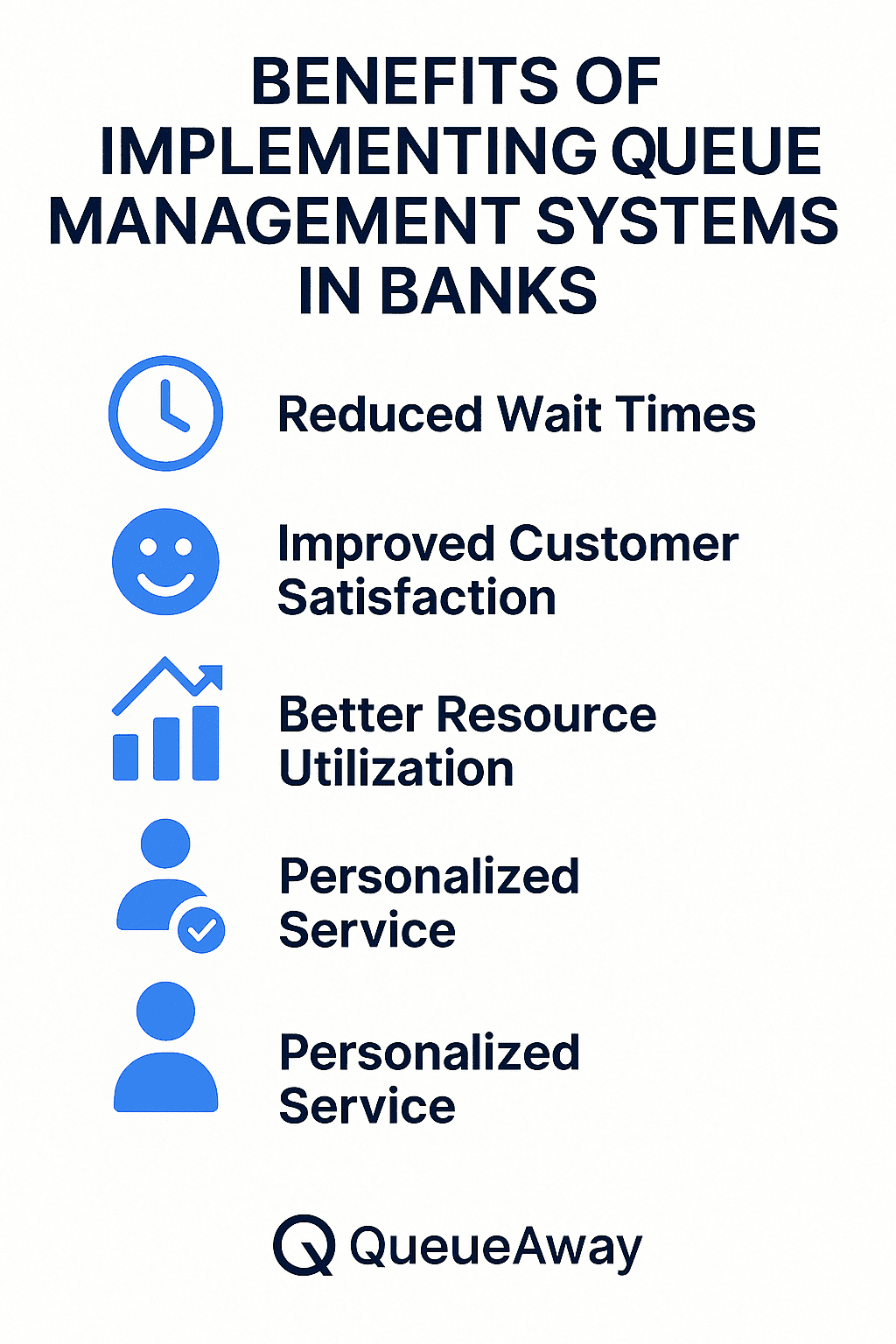
Benefits of Implementing Queue Management Systems in Banks – QueueAwayKey advantages of queue management in banking: reduced wait times, improved customer satisfaction, better resource utilization, and personalized service—enabled by QueueAway.Case Studies: Successful Implementation in Banking Institutions
Several banking institutions have successfully implemented queue management systems, showcasing their transformative impact on customer experience. One notable example is the deployment of such systems by a leading international bank in its branches across major cities. By integrating advanced queue management technologies, the bank was able to significantly reduce wait times and enhance customer satisfaction. The system’s ability to provide real-time updates and personalized service proved crucial in retaining clients and attracting new ones.
Another case study involves a regional bank that faced challenges with high foot traffic and long wait times. By adopting a comprehensive queue management system, the bank streamlined its operations and improved service delivery. The system’s multi-channel queueing options allowed customers to join queues through mobile apps and online portals, reducing congestion at physical branches. Feedback mechanisms enabled the bank to gather valuable insights and continuously refine its processes, leading to a marked improvement in customer experience.
A third example highlights a community bank that leveraged queue management systems to enhance its branch performance. The bank implemented a system that integrated with its CRM platform, allowing for personalized interactions based on customer history and preferences. The real-time analytics provided by the system helped the bank identify peak times and allocate resources efficiently. As a result, the bank experienced increased customer satisfaction, improved staff productivity, and a stronger competitive position in the market.
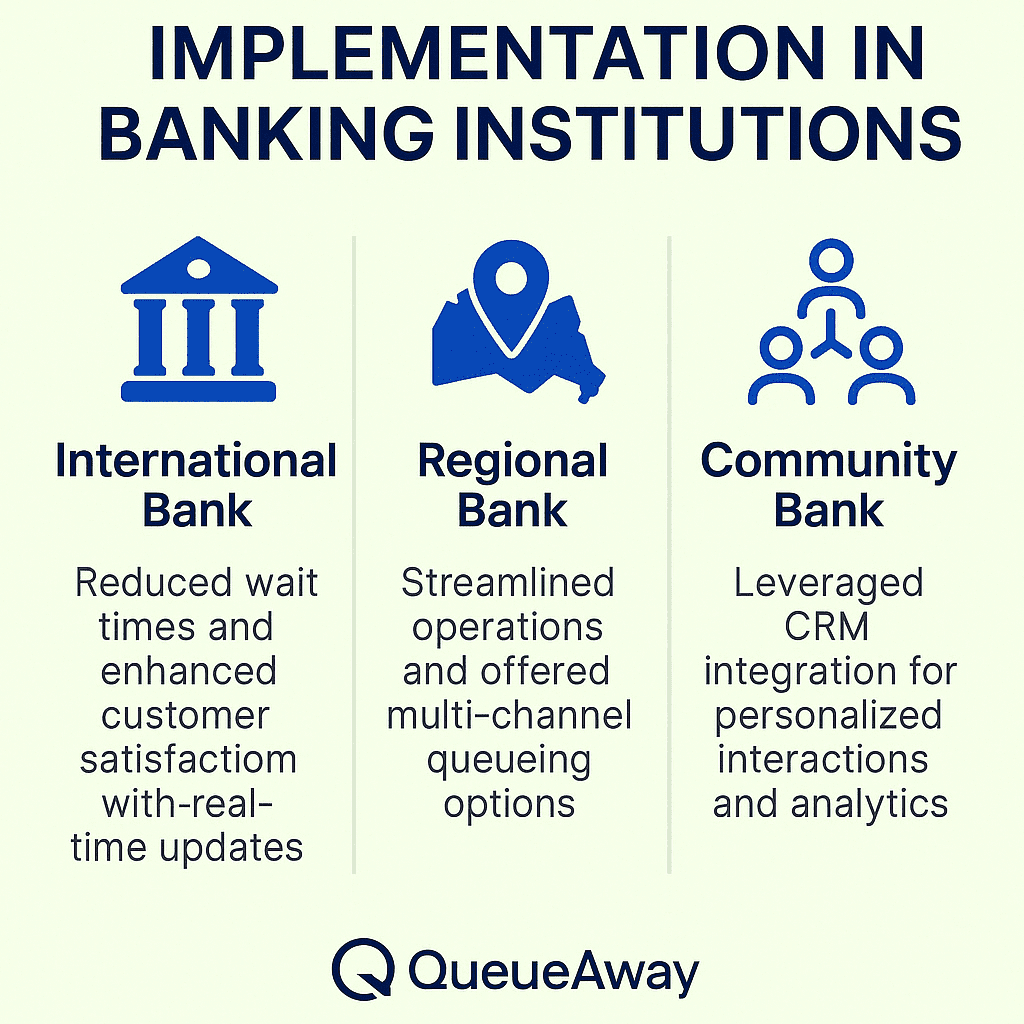
Case Studies: Queue Management System Success in Banking – QueueAwaySuccessful banking case studies—international, regional, and community banks—demonstrating how QueueAway’s systems reduced wait times, optimized operations, and enhanced personalization.Common Challenges and Solutions in Queue Management
Despite the numerous benefits of queue management systems, banks often encounter challenges during their implementation and operation. One common issue is the resistance to change from both customers and staff. Clients accustomed to traditional queueing methods may be hesitant to adopt new technologies, while employees may struggle with the transition to automated systems. To address this, banks must invest in comprehensive training and awareness programs that highlight the advantages of queue management systems and provide support during the transition.
Another challenge is the integration of queue management systems with existing banking technologies. Compatibility issues can arise, leading to inefficiencies and disruptions in service delivery. To overcome this, banks should opt for systems that offer seamless integration with their current infrastructure and provide robust technical support. Additionally, conducting thorough testing and pilot programs can help identify and resolve potential issues before full-scale implementation.
Maintaining system performance and reliability is also a critical concern. Technical glitches, downtime, and system failures can negatively impact customer experience and erode trust. Banks must ensure that their queue management systems are equipped with reliable hardware and software, and have contingency plans in place for emergencies. Regular maintenance, updates, and monitoring can help prevent issues and ensure smooth operation, thereby safeguarding the customer experience.
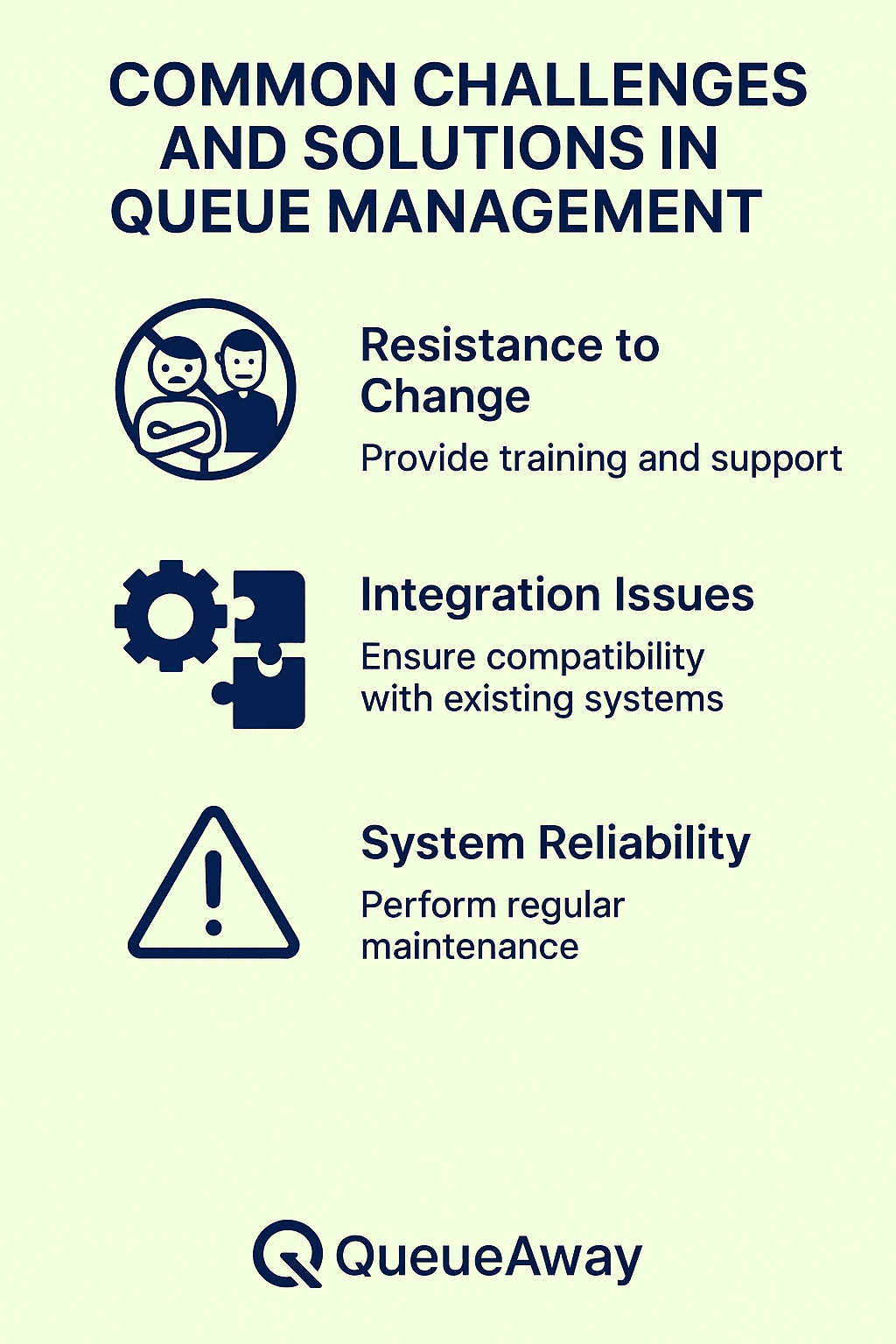
Common Challenges and Solutions in Queue Management – QueueAwayKey challenges banks face with queue management systems—resistance to change, system integration, and reliability—and offers actionable solutions from QueueAway.Future Trends in Queue Management Systems for Banking
As technology continues to evolve, queue management systems are expected to undergo significant advancements, further transforming customer experience in banking. One emerging trend is the use of artificial intelligence (AI) and machine learning to enhance system capabilities. These technologies can analyze vast amounts of data to predict customer behavior, optimize resource allocation, and provide personalized service recommendations. AI-driven systems can also automate routine tasks, freeing up staff to focus on more complex interactions.
Another trend is the integration of biometric authentication in queue management systems. Biometric technologies, such as facial recognition and fingerprint scanning, can streamline customer identification and verification processes, reducing wait times and enhancing security. This integration allows for more efficient and seamless service delivery, improving overall customer satisfaction. Additionally, biometric data can be used to further personalize interactions, creating a more tailored banking experience.
The rise of mobile and digital banking is also influencing the future of queue management systems. As more customers opt for online and mobile services, banks are adapting their queue management strategies to accommodate this shift. Virtual queueing, where clients can join queues remotely and receive updates via their devices, is becoming increasingly popular. This approach offers greater convenience and flexibility, ensuring that customers can access services without the need for physical presence at the branch.
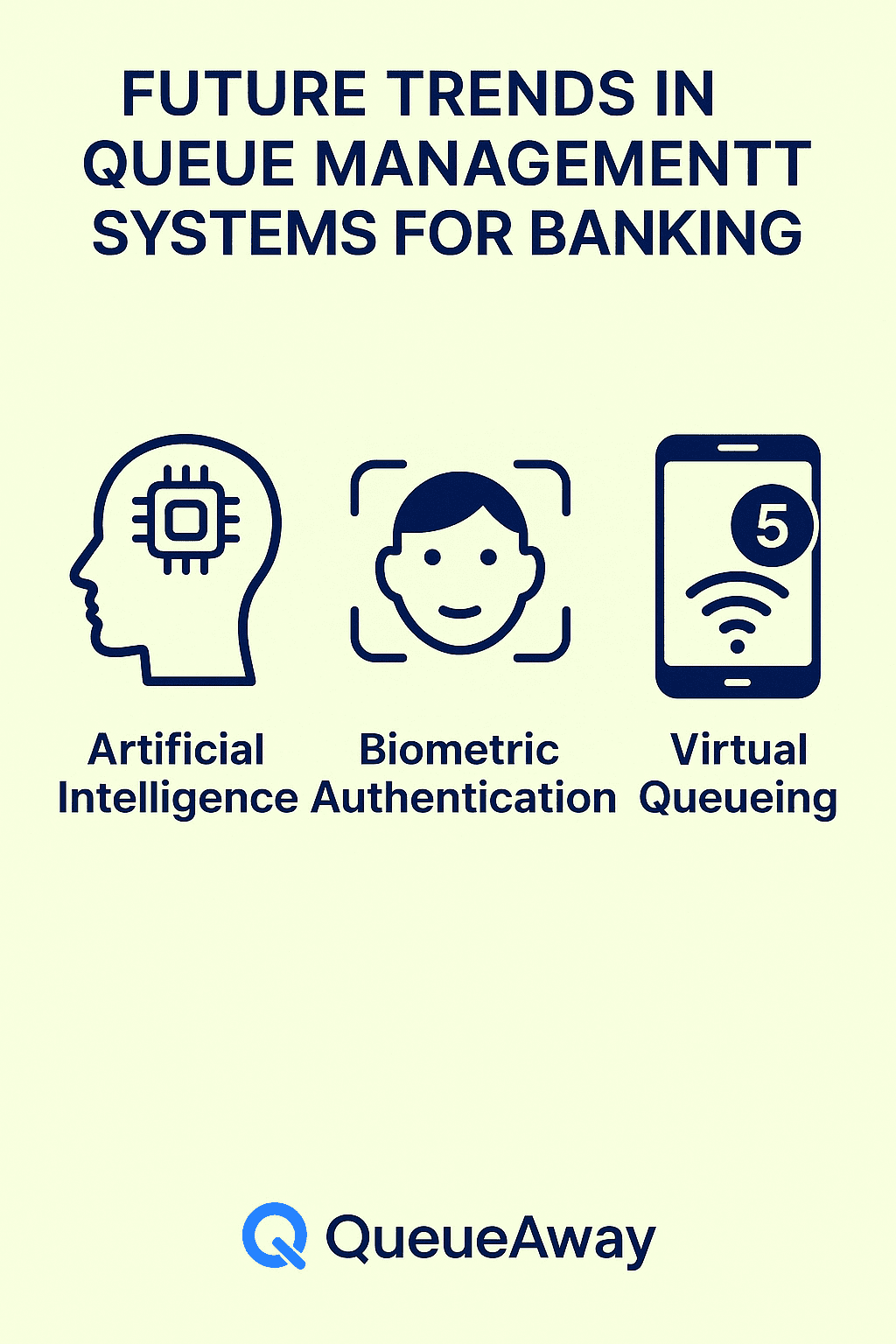
Future Trends in Queue Management Systems for Banking – QueueAwayThe future of queue management in banking, featuring AI, biometric authentication, and virtual queueing—innovations championed by QueueAway to enhance service delivery.Comparing Traditional vs. Modern Queue Management Approaches
Traditional queue management methods often involve manual processes, such as physical queues and token systems. While these approaches can be effective in managing customer flow, they are generally less efficient and offer limited flexibility. Customers may experience longer wait times, lack of transparency, and frustration due to the unpredictability of service delivery. Additionally, traditional methods do not provide the data insights necessary for optimizing operations and enhancing customer experience.
In contrast, modern queue management systems leverage advanced technology to streamline and enhance the queueing process. These systems offer multi-channel queueing options, real-time updates, and personalized service delivery, significantly improving customer experience. The integration of analytics and reporting tools enables banks to monitor performance, identify areas for improvement, and implement targeted strategies. Modern systems also provide greater flexibility and convenience, allowing customers to access services through various platforms.
The shift from traditional to modern queue management approaches represents a significant transformation in banking services. By adopting advanced systems, banks can reduce wait times, optimize resource allocation, and enhance overall efficiency. This transition not only improves customer satisfaction but also positions banks to better compete in a dynamic and evolving market. Ultimately, the adoption of modern queue management systems is a crucial step towards delivering exceptional customer experience in the banking sector.
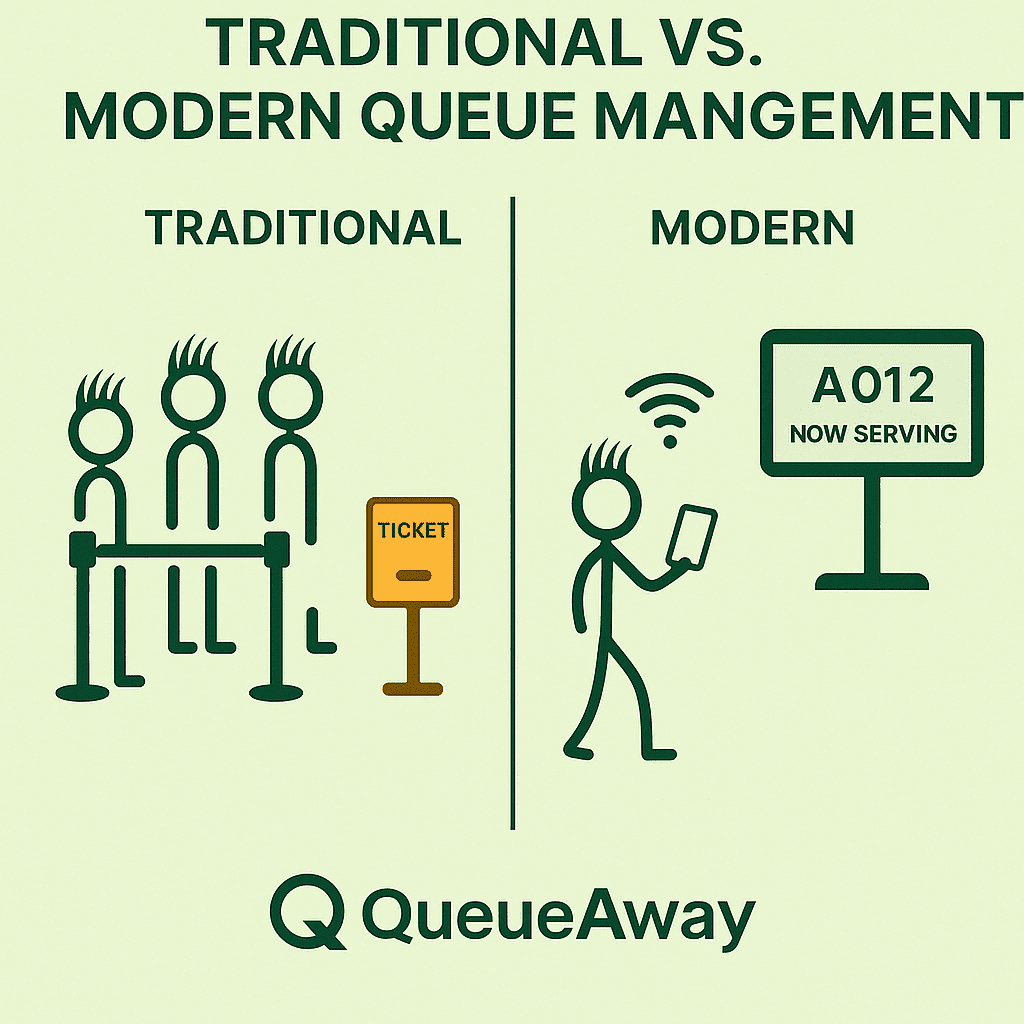
Traditional vs. Modern Queue Management Approaches – QueueAwayThe differences between traditional and modern queue management methods, showcasing QueueAway’s role in transforming customer service through digital innovation.Conclusion: The Future of Customer Experience in Banking
The future of customer experience in banking is undeniably intertwined with the adoption of advanced queue management systems. These systems represent more than just technological innovations; they are pivotal components of a strategic approach to enhancing service delivery and building lasting customer relationships. As banks continue to evolve and adapt to changing customer expectations, the implementation of sophisticated queue management solutions will remain a key priority.
By leveraging the capabilities of modern queue management systems, banks can transform their operations and deliver a superior customer experience. The reduction of wait times, personalized service delivery, and optimized resource allocation contribute to a more efficient and satisfying banking environment. Furthermore, the integration of emerging technologies, such as AI and biometrics, will continue to push the boundaries of what is possible, creating even more seamless and secure interactions.
In conclusion, queue management systems are not just a trend; they are essential tools for revolutionizing customer experience in banking. As financial institutions embrace these solutions, they will be better equipped to meet the demands of a competitive landscape and foster trust and loyalty among their clients. The future of banking is here, and it is guided by the principles of efficiency, personalization, and exceptional service delivery.
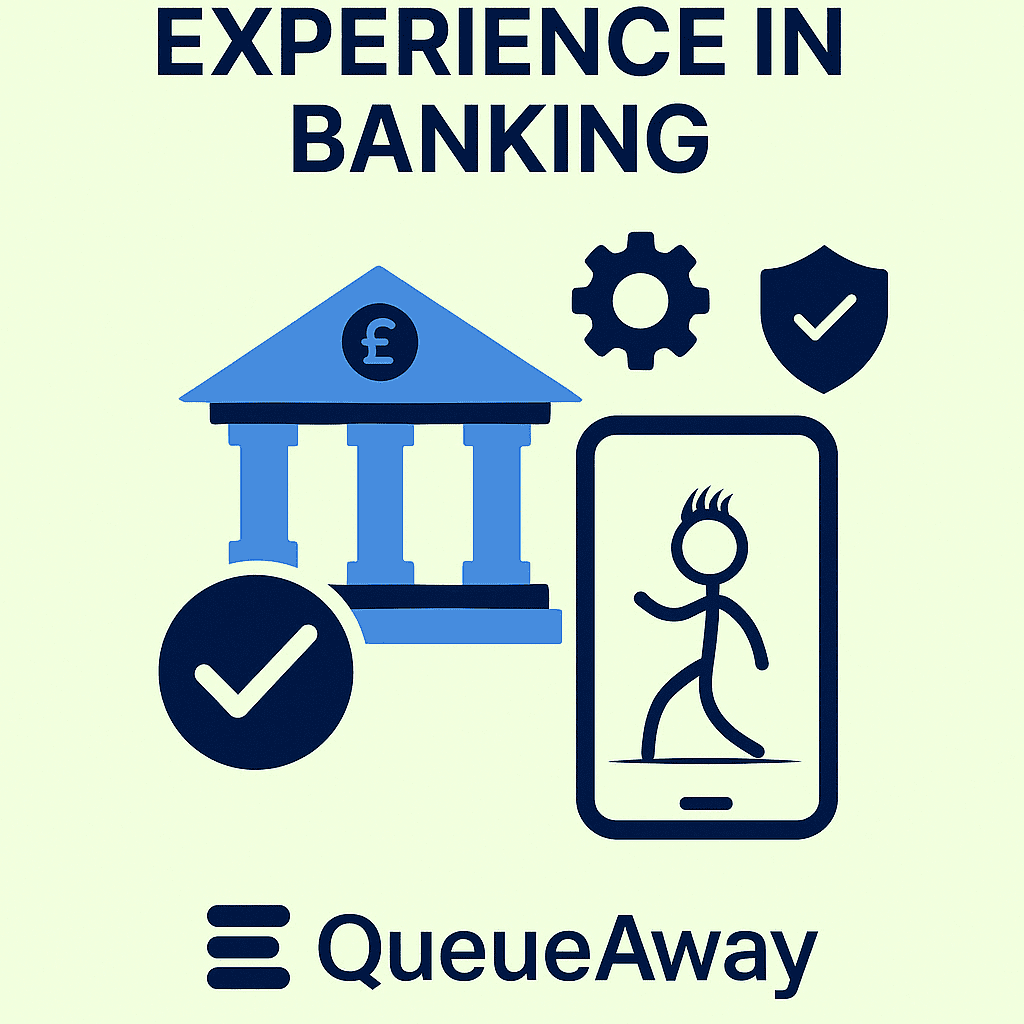
The Future of Customer Experience in Banking – Powered by QueueAway
Capture the future of banking customer experience, highlighting efficiency, personalization, and security as key pillars of QueueAway’s advanced queue management solutions.
Enhance Your Banking Experience with QueueAway
In today's fast-paced financial environment, delivering efficient and seamless customer service is paramount. QueueAway's advanced queue management system is designed to revolutionize the way banks and financial institutions handle customer flow. By integrating virtual queuing, real-time analytics, and automated notifications, QueueAway ensures that your customers spend less time waiting and more time receiving the services they need.
Key Benefits:
Virtual Queuing: Allow customers to join queues remotely via mobile devices, reducing in-branch congestion.
Real-Time Updates: Keep customers informed with live wait times and queue positions, enhancing transparency and trust.
Automated Notifications: Send timely alerts to customers, ensuring they are ready when it's their turn, thereby reducing no-shows.
Data-Driven Insights: Utilize analytics to understand customer behavior, optimize staff allocation, and improve overall service efficiency.
Why Choose QueueAway?
QueueAway is more than just a queuing solution; it's a comprehensive tool tailored for the banking sector. With features like appointment scheduling integration, customizable workflows, and compliance with industry standards, QueueAway addresses the unique challenges faced by financial institutions. Click here to find out more how QueueAway can transform your business
Take the Next Step
Transform your customer service experience and operational efficiency with QueueAway. Visit our homepage to learn more about our offerings and how we can assist your institution in achieving excellence.
Frequently Asked Questions
Q1: What is a queue management system in banking?
A queue management system (QMS) in banking is a digital solution designed to streamline customer flow within bank branches. It enables customers to check in via kiosks, mobile apps, or online portals, and directs them to the appropriate service counters based on their needs. This system reduces wait times, manages customer expectations, and enhances overall service efficiency.
Q2: How does a queue management system improve customer experience in banks?
By minimizing wait times and providing real-time updates, a QMS enhances customer satisfaction. Features like virtual queuing, appointment scheduling, and personalized notifications keep customers informed and engaged, leading to a more pleasant banking experience.
Q3: What are the key features of an effective banking queue management system?
An effective QMS should include:
Virtual Queuing: Allows customers to join a queue remotely.
Appointment Scheduling: Enables customers to book services in advance.
Real-Time Notifications: Keeps customers informed about their position in the queue.
Data Analytics: Provides insights into customer behavior and peak hours.
Integration Capabilities: Seamlessly connects with existing banking systems.
Q4: How does implementing a queue management system benefit bank staff?
A QMS optimizes staff allocation by directing customers to the appropriate service counters, reducing idle time and improving productivity. It also provides staff with real-time data, allowing for better decision-making and resource management.
Q5: Can a queue management system be integrated with other banking services?
Yes, modern QMS solutions can integrate with various banking services such as customer relationship management (CRM) systems, online banking platforms, and feedback tools, ensuring a cohesive and efficient service delivery.


